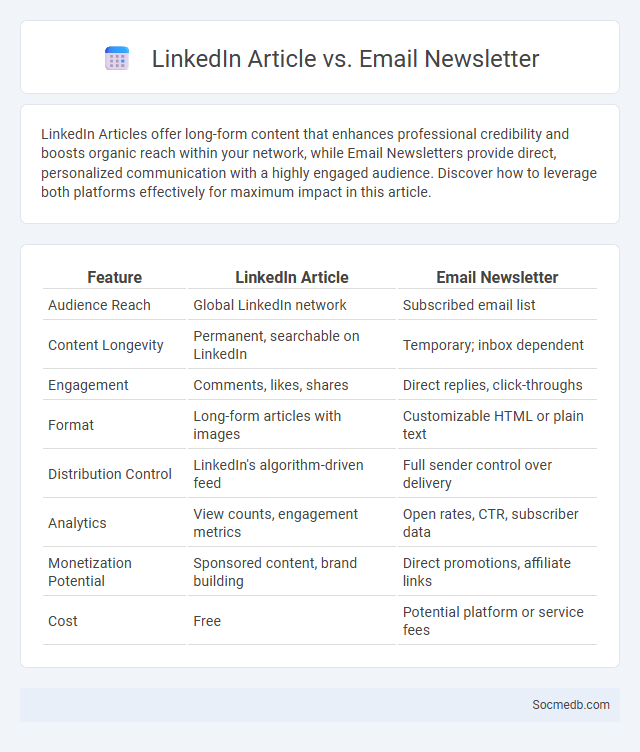
Photo illustration: LinkedIn Article vs Email Newsletter
LinkedIn Articles offer long-form content that enhances professional credibility and boosts organic reach within your network, while Email Newsletters provide direct, personalized communication with a highly engaged audience. Discover how to leverage both platforms effectively for maximum impact in this article.
Table of Comparison
| Feature | LinkedIn Article | Email Newsletter |
|---|---|---|
| Audience Reach | Global LinkedIn network | Subscribed email list |
| Content Longevity | Permanent, searchable on LinkedIn | Temporary; inbox dependent |
| Engagement | Comments, likes, shares | Direct replies, click-throughs |
| Format | Long-form articles with images | Customizable HTML or plain text |
| Distribution Control | LinkedIn's algorithm-driven feed | Full sender control over delivery |
| Analytics | View counts, engagement metrics | Open rates, CTR, subscriber data |
| Monetization Potential | Sponsored content, brand building | Direct promotions, affiliate links |
| Cost | Free | Potential platform or service fees |
Defining LinkedIn Articles, Email Newsletters, and Traditional Articles
LinkedIn Articles are long-form content published directly on the LinkedIn platform, designed to enhance professional credibility and engage a business-focused audience through in-depth insights and industry expertise. Email Newsletters deliver curated content, updates, or promotions directly to subscribers' inboxes, fostering personalized communication and maintaining consistent engagement with a targeted audience. Traditional Articles, typically found in magazines, newspapers, or blogs, provide comprehensive coverage on various topics, emphasizing thorough research and editorial standards to inform or persuade a broad readership.
Audience Reach: Platform vs Direct Subscribers
Social media platforms extend audience reach through algorithm-driven content distribution, enabling access to millions of users beyond a brand's direct subscribers. Direct subscribers ensure consistent engagement and higher retention since they opt-in to receive updates without relying on platform algorithms. Leveraging both strategies optimizes visibility by balancing broad exposure with loyal, targeted communication.
Content Formatting Differences
Social media platforms vary significantly in content formatting, with Instagram prioritizing visually-driven posts like images and short videos, while Twitter emphasizes concise, text-based updates with a 280-character limit. Facebook supports diverse formats including text, photos, videos, and live streams, making it versatile for different content types. TikTok specializes in short-form vertical videos optimized for mobile viewing, leveraging music and effects to enhance engagement.
Engagement and Interaction Capabilities
Social media platforms offer powerful engagement and interaction capabilities that help you connect with your audience through real-time comments, likes, shares, and live streaming features. Advanced algorithms tailor content to maximize user interaction, boosting visibility and fostering community growth. These tools enable brands to build meaningful relationships and drive higher conversion rates by encouraging active participation from followers.
Distribution and Visibility Strategies
Boosting your social media presence requires strategic content distribution across diverse platforms to reach broader audiences and enhance engagement. Leveraging targeted hashtags, influencer partnerships, and optimal posting times increases the visibility of your posts, driving more organic traffic to your profiles. Consistently analyzing platform analytics allows you to refine your approach, ensuring your content resonates with your ideal audience and achieves maximum reach.
SEO Advantages and Limitations
Social media enhances SEO by increasing brand visibility, driving organic traffic, and generating valuable backlinks from high-authority profiles. It facilitates content indexing through frequent sharing and engagement, improving search engine rankings for targeted keywords. However, social signals do not directly influence SEO algorithms, and excessive reliance on social platforms can divert efforts from essential on-site optimization strategies.
Personalization and Targeting Options
Social media platforms offer advanced personalization and targeting options that enable advertisers to reach specific audiences based on demographics, interests, behaviors, and location. Utilizing data analytics and machine learning algorithms, these platforms create tailored ad experiences that increase engagement and conversion rates. Enhanced targeting capabilities include custom audiences, lookalike audiences, and retargeting strategies, optimizing marketing effectiveness for businesses of all sizes.
Analytics and Performance Tracking
Social media analytics and performance tracking provide crucial insights into audience behavior, engagement rates, and content effectiveness across platforms like Facebook, Instagram, and Twitter. Utilizing tools such as Google Analytics, Sprout Social, or Hootsuite allows you to measure key metrics including reach, impressions, click-through rates, and conversion rates, optimizing your content strategy for maximum impact. Your ability to analyze this data empowers better decision-making, improving campaign ROI and driving sustained growth in your social media presence.
Best Use Cases for Each Format
Short videos excel at capturing attention quickly and driving engagement on platforms like TikTok and Instagram Reels. Image posts are ideal for showcasing product visuals and brand aesthetics on Instagram and Facebook, while text-based updates perform well for sharing news and thought leadership on Twitter and LinkedIn. You can maximize your social media strategy by tailoring content to each format's strengths, ensuring enhanced reach and interaction.
Choosing the Right Platform for Your Content Goals
Selecting the right social media platform depends on your content goals and target audience demographics. Visual content performs best on Instagram and TikTok, while LinkedIn is ideal for professional and B2B engagement. Understanding platform algorithms and user behavior ensures you maximize reach and optimize content impact tailored to your objectives.
 socmedb.com
socmedb.com